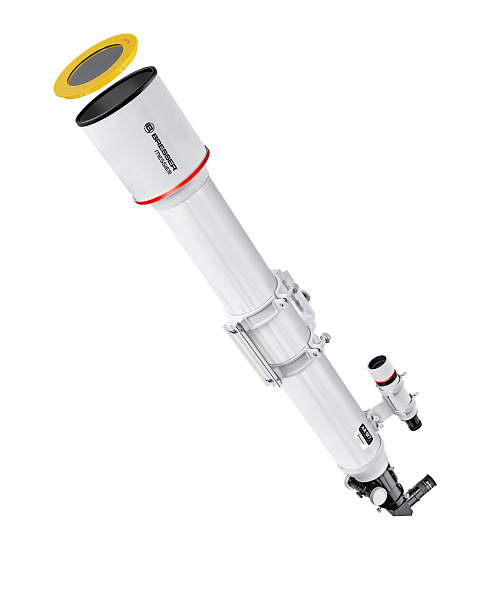Bresser Messier AR-127L/1200 Hexafoc OTA
Achromatic Refractor. Primary mirror diameter: 123mm. Focal length: 1200mm
| Product ID | 74300 |
| Brand | Bresser GmbH, Germany |
| Warranty | 2 |
| EAN | 4007922153643 |
| Package size (LxWxH) | 41x25x20 |
| Shipping Weight | 2.9 |
NEW - now including a high-quality aperture Solar-filter for safe observation of sunspots, eclipses and planet transits. Great telescope for night and solar observation.
For the price-sensitive planetary observer the Bresser Messier AR-127L telescope is a dream machine. View tiny dots and structures in the cloud bands of Jupiter, small rims and craters on the surface of the moon and details on Mars, including the ice-covered polar regions of our neighbouring planet. Watch Jupiter's moons dance around the planet and detect the greenish glow of Uranus far beyond Saturns orbit. The Bresser Messier AR-127L's combination of large aperture and long focal length provides tack-sharp high-contrast pictures that will impress you every time anew.
Features:
- Optical design: refractor telescope
- Lens diameter: 127 mm / focal length: 1200 mm / F/9.4
- Maximum recommended magnification: 254x
- Very high quality Hexafoc focuser with 2.5" free inner diameter
- 8x50 straight through viewfinder;optimized finder bracket for comfortable use
- 31.7 mm (1.25") diagonal mirror
- Cradle rings with handle and integrated piggyback camera holder (1/4'' thread)
- Universal 44mm Dovetail plate with stainless steel rail (fits LXD75/Great Polaris/EQ5)
- 50,8mm (2'') to 31,7mm (1,25'') adapter with integrated T2 thread (optional T2-adapter ring for your camera is needed)
- Smartphone adapter for sky navigation included
- Telescope for night and solar observation
The kit includes:
- Optical tube
- Eyepiece: 26 mm Super Ploessl 31.7 mm (1.25")
- 31,7 mm (1,25") diagonal mirror
- Integrated 31,7 mm and T2 adapter
- Prism rail with stainless steel clamping surface (44mm universal dovetrail for GP/EQ5/LXD75)
- 8x50 viewfinder
- Rotable star chart
- Objective Solar-filter
- Tube clamp with handle and camera holder
- Smartphone camera adapter
- Software Stellarium (via Download)
| Product ID | 74300 |
| Brand | Bresser GmbH, Germany |
| Warranty | 2 |
| EAN | 4007922153643 |
| Package size (LxWxH) | 41x25x20 |
| Shipping Weight | 2.9 |
| Optical design | refractor |
| Optical scheme | achromat |
| Optics coating | multi-coated |
| Objective lens diameter (aperture), mm | 127 |
| Focal length, mm | 1200 |
| Aperture ratio | f/9.4 |
| Resolution threshold, arcseconds | 1 |
| Eyepieces | Super Plössl 26mm (17х) |
| Finderscope | 8x50 |
| Solar filter included | ✓ |
| Additional | smartphone adapter included, dust protection caps for an open aperture and eyepiece holder |
| Optical tube mounting mode | dovetail plate |
| Optical tube material | aluminum |
| User level | beginners |
| Observed object | deep-sky objects, planets of the Solar System, the Sun |
Convenient diagrams that describe how to install additional accessories on refractors and catadioptric telescopes
Find out how to assemble a telescope on an example of the Levenhuk Skyline 90x900 EQ telescope
This short guide will help you avoid typical mistakes and learn more about telescope and mounting types
The basics of astronomical observations for beginners
In this article we have gathered answers to some of the most frequently asked questions about telescopes
How telescopes work?
You can actually perform observations from your balcony!
All about telescope sizes, types, magnification, and mounts
Learn how to set up and use the telescope properly
Astronomy in light-polluted skies. Find out what you can observe in the city
Read an interesting comprehensive article on telescopes for little astronomers
Celestial objects you can observe with telescopes of different apertures
Colored and vivid images of galaxies, planets and star clusters entrance everyone who is fascinated by boundless space
Find an interesting review on the history of the changes to a refracting telescope
To make the process of choosing a telescope easier, we will tell you about the characteristics of the most popular types of telescopes today
Learn everything you need to know about refractor telescopes to make the right choice










